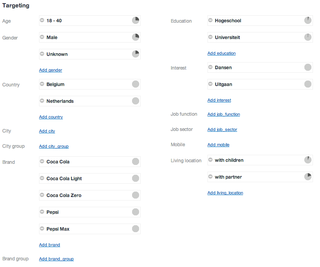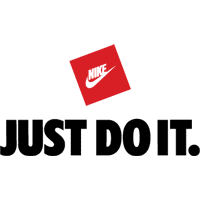
Advertising is the practice and techniques employed to bring attention to a product or service. Advertising aims to put a product or service in the spotlight in hopes of drawing it attention from consumers. It is typically used to promote a specific good or service, but there are wide range of uses, the most common being the commercial advertisement.

A television advertisement is a span of television programming produced and paid for by an organization. It conveys a message promoting, and aiming to market, a product, service or idea. Advertisers and marketers may refer to television commercials as TVCs.

Sex appeal is often used in advertising to help sell a particular product or service. According to research, sexually appealing content, such as imagery, used for marketing does not need to pertain directly to the product or service in question. Rather, such content is utilized as an attempt to shape or shift brand image held by the consumer. As more companies have adopted the strategy of "sex sells", the prevalence of sexual campaigns has led to controversy. Consumers in society have voiced concern over the techniques and content used to titillate audiences, often stemming from the fact that such ads challenge conventional morals and cultural standards.

Sneakers (US) or trainers (UK), also known by a wide variety of other names, are shoes primarily designed for sports or other forms of physical exercise but which are also widely used for everyday casual wear.
Digital display advertising is online graphic advertising through banners, text, images, video, and audio. The main purpose of digital display advertising is to post company ads on third-party websites. A display ad is usually interactive, which allows brands and advertisers to engage deeper with the users. A display ad can also be a companion ad for a non-clickable video ad.
Click fraud is a type of fraud that occurs on the Internet in pay-per-click (PPC) online advertising. In this type of advertising, the owners of websites that post the ads are paid based on how many site visitors click on the ads. Fraud occurs when a person, automated script, computer program or an auto clicker imitates a legitimate user of a web browser, clicking on such an ad without having an actual interest in the target of the ad's link in order to increase revenue. Click fraud is the subject of some controversy and increasing litigation due to the advertising networks being a key beneficiary of the fraud.

Nicotine marketing is the marketing of nicotine-containing products or use. Traditionally, the tobacco industry markets cigarette smoking, but it is increasingly marketing other products, such as electronic cigarettes and heated tobacco products. Products are marketed through social media, stealth marketing, mass media, and sponsorship. Expenditures on nicotine marketing are in the tens of billions a year; in the US alone, spending was over US$1 million per hour in 2016; in 2003, per-capita marketing spending was $290 per adult smoker, or $45 per inhabitant. Nicotine marketing is increasingly regulated; some forms of nicotine advertising are banned in many countries. The World Health Organization recommends a complete tobacco advertising ban.

Cosmetic advertising is the promotion of cosmetics and beauty products by the cosmetics industry through a variety of media. The advertising campaigns are usually aimed at women wishing to improve their appearance, commonly to increase physical attractiveness and reduce the signs of ageing.

Reebok Freestyle is an athletic shoe style introduced in 1982 by Reebok. The Freestyle was the first sneaker designed and marketed for women. It helped Reebok into the mainstream athletic wear market and fashion scene along with becoming one of the most popular athletic shoes of all time. In 1984, the shoe accounted for more than half of Reebok sales. The Reebok Freestyle was popular during the 1980s aerobics craze and is still in production and remodeled through various collections and style variations.

LA Gear is an American shoe company based in Los Angeles, California. Founded in 1983, the brand is currently owned by ACI International.

Reebok International Limited is an American fitness footwear and clothing brand that is a part of Authentic Brands Group. It was established in England in 1958 as a companion company to J.W. Foster and Sons, a sporting goods company which had been founded in 1895 in Bolton, Lancashire. From 1958 until 1986, the brand featured the flag of the United Kingdom in its logo to signify the origins of the company. It was bought by German sporting goods company Adidas in 2005, then sold to the United States-based Authentic Brands Group in 2021. The company's global headquarters are located in Boston, Massachusetts, in the Seaport District.
Mobile advertising is a form of advertising via mobile (wireless) phones or other mobile devices. It is a subset of mobile marketing, mobile advertising can take place as text ads via SMS, or banner advertisements that appear embedded in a mobile web site.
"Youth Marketing" is a term used in the marketing and advertising industry to describe activities to communicate with young people, typically in the age range of 11 to 35. More specifically, there is teen marketing, targeting people age 11 to 17, college marketing, targeting college-age consumers, typically ages 18 to 24, and young adult marketing, targeting ages 25 to 34.

Targeted advertising is a form of advertising, including online advertising, that is directed towards an audience with certain traits, based on the product or person the advertiser is promoting. These traits can either be demographic with a focus on race, economic status, sex, age, generation, level of education, income level, and employment, or psychographic focused on the consumer values, personality, attitude, opinion, lifestyle and interest. This focus can also entail behavioral variables, such as browser history, purchase history, and other recent online activities. The process of algorithm targeting eliminates waste.
Social network advertising, also social media targeting, is a group of terms that are used to describe forms of online advertising/digital marketing that focus on social networking services. One of the major benefits of this type of advertising is that advertisers can take advantage of the users' demographic information and target their ads appropriately.

Nike, Inc. is an American multinational corporation that is engaged in the design, development, manufacturing, and worldwide marketing and sales of footwear, apparel, equipment, accessories, and services. The company is headquartered near Beaverton, Oregon, in the Portland metropolitan area. It is the world's largest supplier of athletic shoes and apparel and a major manufacturer of sports equipment, with revenue in excess of US$46 billion in its fiscal year 2022.
Reebok International Limited is a global producer of athletic footwear, apparel, and accessories; and was a subsidiary of Adidas since 2005, until it was sold to Authentic Brands Group in 2021. Reebok has marketed itself using a variety of ad campaigns.

Tag is a television and cinema advertisement launched by Nike Inc. in 2001 to promote its line of sportswear in the United States. It was one of four pieces forming the television component of the $25m "Play" campaign, which had been running for several months. Tag was created by advertising agency Wieden+Kennedy. Production was handled by production company Gorgeous Enterprises, who assigned director Frank Budgen to oversee the project. Filming took place in Toronto, Ontario.

Just Do It or JDI for short is a trademark of shoe company Nike. The slogan was coined in 1988 at an advertising agency meeting. The founder of the Wieden+Kennedy agency, Dan Wieden, credits the inspiration for his "Just Do It" Nike slogan to death row Gary Gilmore’s last words: "Let's do it." From 1988 to 1998, Nike increased its share of the North American domestic sport-shoe business from 18% to 43%. In many Nike-related situations, "Just Do It" appears alongside the Nike logo, known as the Swoosh.
Advertisements in schools is a controversial issue that is debated in the United States. Naming rights of sports stadiums and fields, sponsorship of sports teams, placement of signage, vending machine product selection and placement, and free products that children can take home or keep at school are all prominent forms of advertisements in schools.












